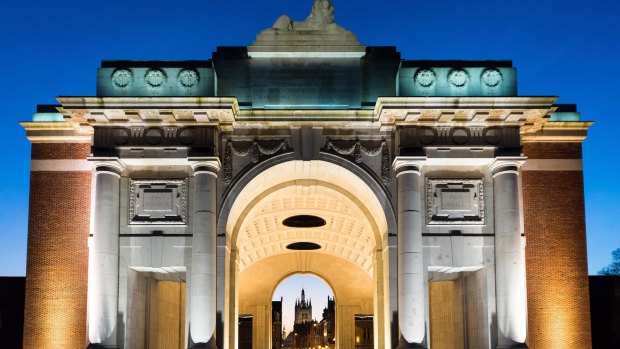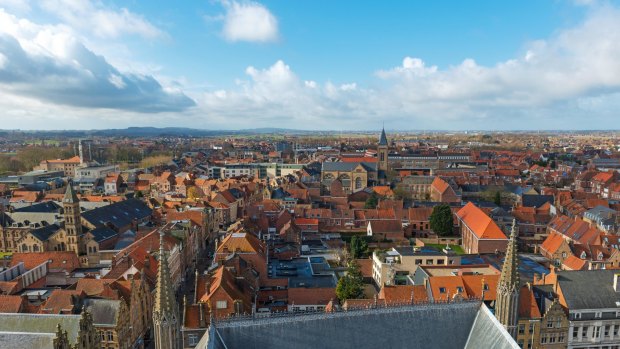This was published 5 years ago
Ypres, Belgium, battlefield tours: A living place of the dead
By Alison Stewart

Menin Gate's Memorial to the Missing in Ypres.Credit: Shutterstock
Ypres is not simply a city but a state of mind – a symbolic place of pilgrimage and memorial to resilience. Though German bombardment during World War I reduced it to rubble, it held out against invasion, a defiant corner of Belgian Flanders.
It stands today, rebuilt exactly as it had been before the war, now a place of peace in the midst of terrain still seeded with the bodies of war dead. If some had had their way, the town would have been left as a ruin in memoriam.
But Belgium and France wanted things put back as they were. With German reparation money, they rebuilt the town exactly as it was.

Ypres was rebuilt exactly as it had been before World War I.Credit: Shutterstock
If you look beyond the lively contemporary city, with its coffee shops, cafes and restaurants, Ypres presents a paradox – a living place of the dead. Its landscape offers a vivid narrative to those journeying to remember family members and friends whose lives were ruined by war.
So sacred is Ypres, and momentous in its place in war history, King George V awarded the city the Military Cross in 1920, along with Verdun, one of only two Great War city awards. Travellers criss-crossing this raw landscape littered with stories of hardship, courage, misery, loss and vainglory cannot fail to be moved.
Ypres, now called by its Flemish name, Ieper, heavy with history, must not be missed on an expedition to the Western Front. It is the launch point to Flanders' so-called "silent cities" of surrounding war cemeteries, memorials and battlefields.
Beginning in the 1920s, Ypres became a symbolic pilgrimage destination where people could imagine the suffering and gain spiritual help. Every part of Ypres was sacred, they believed, and is sacred still.
And so people come not simply to visit a lovely town but also to remember, as we have on our Remembrance Day tour of the Western Front's Australian battlefields, making Ypres our Flanders base.
The city stood in the path of the Germans' "race to the sea" and was surrounded on three sides and bombarded during much of the war. Allied forces fought costly battles from the Ypres Salient – the area around the city that saw some of the most vicious battles of the Great War.
The best known, largest and most awful battle with half a million casualties was the Third Battle of Ypres (Passchendaele). But peace now inhabits this town. On the day of the Armistice centenary at Villers-Bretonneux, children from the Koningsdale Steinerschool join us at breakfast to sing songs of humanity.
Our war historian, Pete Smith, takes us on a walking tour of the town – an excellent way to identify the waymarkers of Belgian Flanders' war history, for the war's myriad complexities need expert interpretation.
We begin at St Jacob's Church, a standing reminder of the destruction Ypres endured. Only the doorway survived the German bombing – the church collapsed on top of it, protecting it. Ypres's charming "ankle-breaker" cobblestones were hell for soldiers in studded boots.
Ypres' earthen ramparts built by King Louis XIV's military engineer, the Marquis de Vauban, deserve inanimate hero status. During World War I, shelters were dug to house resting soldiers, powder stores and rear units. The ramparts gave protection from the shelling when all around was smashed to red dust.
A more peaceful scene presents as we walk the linden tree-lined ramparts, looking out across the moat towards the Salient, Menin Road and Hellfire Corner – once "the hottest place on earth".
An Ypres highlight is one of the world's best-known war memorials – Menin Gate. We have already attended the 8pm Last Post ceremony, undertaken every evening since 1929, except during the German occupation of 1940 to 1944.
Armies of tourists come to this magnificent Memorial to the Missing, inscribed with the names of 54,900 soldiers (6000 Australians) who died before August 16, 1917, and have no known grave. It stands also as a reminder of the hundreds of thousands of servicemen who marched out to the battlefields through the eastern gate.
Beyond this gate are the Menin Gate lions. In 1936, the Ypres mayor donated to the Australian War Memorial the two limestone lions in gratitude for the sacrifice made by thousands of Australian soldiers in Belgium.
During our time in Flanders, replicas of the lions arrived back in Ypres, gifted by Australia in recognition of the Armistice Centenary.
There are other stops on our tour including the rebuilt Cloth Hall, once the centre of the medieval textile trade and now housing the In Flanders Museum, and the little Ramparts (Lille Gate) Cemetery containing the graves of 198 soldiers.
There's much to see and much to contemplate. We leave Ypres feeling that we have "passed from the shadow of history into the light of day".
Alison Stewart's tour was courtesy of Mat McLachlan Battlefield Tours
TRIP NOTES
MORE
traveller.com.au/search?text=western+front
toerisme-ieper.be/en/home.html
TOUR
Mat McLachlan Battlefield Tours operates a variety of Western Front battlefields tours from April to November. His four-day Western Front Explorer Tour in 2019 costs $1997 a person twin-share. See battlefields.com.au/
FLY
Vietnam Airlines flies daily from Sydney and Melbourne to Paris via Ho Chi Minh City. See vietnamairlines.com/
Sign up for the Traveller Deals newsletter
Get exclusive travel deals delivered straight to your inbox. Sign up now.